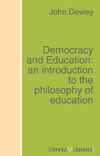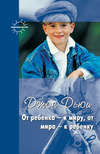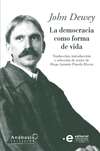Читать книгу: «Democracy and Education: an introduction to the philosophy of education», страница 4
Suppose that some one rolls a ball to a child; he catches it and rolls it back, and the game goes on. Here the stimulus is not just the sight of the ball, or the sight of the other rolling it. It is the situation – the game which is playing. The response is not merely rolling the ball back; it is rolling it back so that the other one may catch and return it, – that the game may continue. The "pattern" or model is not the action of the other person. The whole situation requires that each should adapt his action in view of what the other person has done and is to do. Imitation may come in but its role is subordinate. The child has an interest on his own account; he wants to keep it going. He may then note how the other person catches and holds the ball in order to improve his own acts. He imitates the means of doing, not the end or thing to be done. And he imitates the means because he wishes, on his own behalf, as part of his own initiative, to take an effective part in the game. One has only to consider how completely the child is dependent from his earliest days for successful execution of his purposes upon fitting his acts into those of others to see what a premium is put upon behaving as others behave, and of developing an understanding of them in order that he may so behave. The pressure for likemindedness in action from this source is so great that it is quite superfluous to appeal to imitation. As matter of fact, imitation of ends, as distinct from imitation of means which help to reach ends, is a superficial and transitory affair which leaves little effect upon disposition. Idiots are especially apt at this kind of imitation; it affects outward acts but not the meaning of their performance. When we find children engaging in this sort of mimicry, instead of encouraging them (as we would do if it were an important means of social control) we are more likely to rebuke them as apes, monkeys, parrots, or copy cats. Imitation of means of accomplishment is, on the other hand, an intelligent act. It involves close observation, and judicious selection of what will enable one to do better something which he already is trying to do. Used for a purpose, the imitative instinct may, like any other instinct, become a factor in the development of effective action.
This excursus should, accordingly, have the effect of reinforcing the conclusion that genuine social control means the formation of a certain mental disposition; a way of understanding objects, events, and acts which enables one to participate effectively in associated activities. Only the friction engendered by meeting resistance from others leads to the view that it takes place by forcing a line of action contrary to natural inclinations. Only failure to take account of the situations in which persons are mutually concerned (or interested in acting responsively to one another) leads to treating imitation as the chief agent in promoting social control.
4. Some Applications to Education. Why does a savage group perpetuate savagery, and a civilized group civilization? Doubtless the first answer to occur to mind is because savages are savages; being of low-grade intelligence and perhaps defective moral sense. But careful study has made it doubtful whether their native capacities are appreciably inferior to those of civilized man. It has made it certain that native differences are not sufficient to account for the difference in culture. In a sense the mind of savage peoples is an effect, rather than a cause, of their backward institutions. Their social activities are such as to restrict their objects of attention and interest, and hence to limit the stimuli to mental development. Even as regards the objects that come within the scope of attention, primitive social customs tend to arrest observation and imagination upon qualities which do not fructify in the mind. Lack of control of natural forces means that a scant number of natural objects enter into associated behavior. Only a small number of natural resources are utilized and they are not worked for what they are worth. The advance of civilization means that a larger number of natural forces and objects have been transformed into instrumentalities of action, into means for securing ends. We start not so much with superior capacities as with superior stimuli for evocation and direction of our capacities. The savage deals largely with crude stimuli; we have weighted stimuli. Prior human efforts have made over natural conditions. As they originally existed they were indifferent to human endeavors. Every domesticated plant and animal, every tool, every utensil, every appliance, every manufactured article, every esthetic decoration, every work of art means a transformation of conditions once hostile or indifferent to characteristic human activities into friendly and favoring conditions. Because the activities of children today are controlled by these selected and charged stimuli, children are able to traverse in a short lifetime what the race has needed slow, tortured ages to attain. The dice have been loaded by all the successes which have preceded.
Stimuli conducive to economical and effective response, such as our system of roads and means of transportation, our ready command of heat, light, and electricity, our ready-made machines and apparatus for every purpose, do not, by themselves or in their aggregate, constitute a civilization. But the uses to which they are put are civilization, and without the things the uses would be impossible. Time otherwise necessarily devoted to wresting a livelihood from a grudging environment and securing a precarious protection against its inclemencies is freed. A body of knowledge is transmitted, the legitimacy of which is guaranteed by the fact that the physical equipment in which it is incarnated leads to results that square with the other facts of nature. Thus these appliances of art supply a protection, perhaps our chief protection, against a recrudescence of these superstitious beliefs, those fanciful myths and infertile imaginings about nature in which so much of the best intellectual power of the past has been spent. If we add one other factor, namely, that such appliances be not only used, but used in the interests of a truly shared or associated life, then the appliances become the positive resources of civilization. If Greece, with a scant tithe of our material resources, achieved a worthy and noble intellectual and artistic career, it is because Greece operated for social ends such resources as it had. But whatever the situation, whether one of barbarism or civilization, whether one of stinted control of physical forces, or of partial enslavement to a mechanism not yet made tributary to a shared experience, things as they enter into action furnish the educative conditions of daily life and direct the formation of mental and moral disposition.
Intentional education signifies, as we have already seen, a specially selected environment, the selection being made on the basis of materials and method specifically promoting growth in the desired direction. Since language represents the physical conditions that have been subjected to the maximum transformation in the interests of social life – physical things which have lost their original quality in becoming social tools – it is appropriate that language should play a large part compared with other appliances. By it we are led to share vicariously in past human experience, thus widening and enriching the experience of the present. We are enabled, symbolically and imaginatively, to anticipate situations. In countless ways, language condenses meanings that record social outcomes and presage social outlooks. So significant is it of a liberal share in what is worth while in life that unlettered and uneducated have become almost synonymous.
The emphasis in school upon this particular tool has, however, its dangers – dangers which are not theoretical but exhibited in practice. Why is it, in spite of the fact that teaching by pouring in, learning by a passive absorption, are universally condemned, that they are still so entrenched in practice? That education is not an affair of "telling" and being told, but an active and constructive process, is a principle almost as generally violated in practice as conceded in theory. Is not this deplorable situation due to the fact that the doctrine is itself merely told? It is preached; it is lectured; it is written about. But its enactment into practice requires that the school environment be equipped with agencies for doing, with tools and physical materials, to an extent rarely attained. It requires that methods of instruction and administration be modified to allow and to secure direct and continuous occupations with things. Not that the use of language as an educational resource should lessen; but that its use should be more vital and fruitful by having its normal connection with shared activities. "These things ought ye to have done, and not to have left the others undone." And for the school "these things" mean equipment with the instrumentalities of cooperative or joint activity.
For when the schools depart from the educational conditions effective in the out-of-school environment, they necessarily substitute a bookish, a pseudo-intellectual spirit for a social spirit. Children doubtless go to school to learn, but it has yet to be proved that learning occurs most adequately when it is made a separate conscious business. When treating it as a business of this sort tends to preclude the social sense which comes from sharing in an activity of common concern and value, the effort at isolated intellectual learning contradicts its own aim. We may secure motor activity and sensory excitation by keeping an individual by himself, but we cannot thereby get him to understand the meaning which things have in the life of which he is a part. We may secure technical specialized ability in algebra, Latin, or botany, but not the kind of intelligence which directs ability to useful ends. Only by engaging in a joint activity, where one person's use of material and tools is consciously referred to the use other persons are making of their capacities and appliances, is a social direction of disposition attained.
Summary. The natural or native impulses of the young do not agree with
the life-customs of the group into which they are born. Consequently they have to be directed or guided. This control is not the same thing as physical compulsion; it consists in centering the impulses acting at any one time upon some specific end and in introducing an order of continuity into the sequence of acts. The action of others is always influenced by deciding what stimuli shall call out their actions. But in some cases as in commands, prohibitions, approvals, and disapprovals, the stimuli proceed from persons with a direct view to influencing action. Since in such cases we are most conscious of controlling the action of others, we are likely to exaggerate the importance of this sort of control at the expense of a more permanent and effective method. The basic control resides in the nature of the situations in which the young take part. In social situations the young have to refer their way of acting to what others are doing and make it fit in. This directs their action to a common result, and gives an understanding common to the participants. For all mean the same thing, even when performing different acts. This common understanding of the means and ends of action is the essence of social control. It is indirect, or emotional and intellectual, not direct or personal. Moreover it is intrinsic to the disposition of the person, not external and coercive. To achieve this internal control through identity of interest and understanding is the business of education. While books and conversation can do much, these agencies are usually relied upon too exclusively. Schools require for their full efficiency more opportunity for conjoint activities in which those instructed take part, so that they may acquire a social sense of their own powers and of the materials and appliances used.
Chapter Four: Education as Growth
1. The Conditions of Growth.
In directing the activities of the young, society determines its own future in determining that of the young. Since the young at a given time will at some later date compose the society of that period, the latter's nature will largely turn upon the direction children's activities were given at an earlier period. This cumulative movement of action toward a later result is what is meant by growth.
The primary condition of growth is immaturity. This may seem to be a mere truism – saying that a being can develop only in some point in which he is undeveloped. But the prefix "im" of the word immaturity means something positive, not a mere void or lack. It is noteworthy that the terms "capacity" and "potentiality" have a double meaning, one sense being negative, the other positive. Capacity may denote mere receptivity, like the capacity of a quart measure. We may mean by potentiality a merely dormant or quiescent state – a capacity to become something different under external influences. But we also mean by capacity an ability, a power; and by potentiality potency, force. Now when we say that immaturity means the possibility of growth, we are not referring to absence of powers which may exist at a later time; we express a force positively present – the ability to develop.
Our tendency to take immaturity as mere lack, and growth as something which fills up the gap between the immature and the mature is due to regarding childhood comparatively, instead of intrinsically. We treat it simply as a privation because we are measuring it by adulthood as a fixed standard. This fixes attention upon what the child has not, and will not have till he becomes a man. This comparative standpoint is legitimate enough for some purposes, but if we make it final, the question arises whether we are not guilty of an overweening presumption. Children, if they could express themselves articulately and sincerely, would tell a different tale; and there is excellent adult authority for the conviction that for certain moral and intellectual purposes adults must become as little children. The seriousness of the assumption of the negative quality of the possibilities of immaturity is apparent when we reflect that it sets up as an ideal and standard a static end. The fulfillment of growing is taken to mean an accomplished growth: that is to say, an Ungrowth, something which is no longer growing. The futility of the assumption is seen in the fact that every adult resents the imputation of having no further possibilities of growth; and so far as he finds that they are closed to him mourns the fact as evidence of loss, instead of falling back on the achieved as adequate manifestation of power. Why an unequal measure for child and man?
Taken absolutely, instead of comparatively, immaturity designates a positive force or ability, – the power to grow. We do not have to draw out or educe positive activities from a child, as some educational doctrines would have it. Where there is life, there are already eager and impassioned activities. Growth is not something done to them; it is something they do. The positive and constructive aspect of possibility gives the key to understanding the two chief traits of immaturity, dependence and plasticity.
(1) It sounds absurd to hear dependence spoken of as something positive, still more absurd as a power. Yet if helplessness were all there were in dependence, no development could ever take place. A merely impotent being has to be carried, forever, by others. The fact that dependence is accompanied by growth in ability, not by an ever increasing lapse into parasitism, suggests that it is already something constructive. Being merely sheltered by others would not promote growth. For
(2) it would only build a wall around impotence. With reference to the physical world, the child is helpless. He lacks at birth and for a long time thereafter power to make his way physically, to make his own living. If he had to do that by himself, he would hardly survive an hour. On this side his helplessness is almost complete. The young of the brutes are immeasurably his superiors. He is physically weak and not able to turn the strength which he possesses to coping with the physical environment.
1. The thoroughgoing character of this helplessness suggests, however, some compensating power. The relative ability of the young of brute animals to adapt themselves fairly well to physical conditions from an early period suggests the fact that their life is not intimately bound up with the life of those about them. They are compelled, so to speak, to have physical gifts because they are lacking in social gifts. Human infants, on the other hand, can get along with physical incapacity just because of their social capacity. We sometimes talk and think as if they simply happened to be physically in a social environment; as if social forces exclusively existed in the adults who take care of them, they being passive recipients. If it were said that children are themselves marvelously endowed with power to enlist the cooperative attention of others, this would be thought to be a backhanded way of saying that others are marvelously attentive to the needs of children. But observation shows that children are gifted with an equipment of the first order for social intercourse. Few grown-up persons retain all of the flexible and sensitive ability of children to vibrate sympathetically with the attitudes and doings of those about them. Inattention to physical things (going with incapacity to control them) is accompanied by a corresponding intensification of interest and attention as to the doings of people. The native mechanism of the child and his impulses all tend to facile social responsiveness. The statement that children, before adolescence, are egotistically self-centered, even if it were true, would not contradict the truth of this statement. It would simply indicate that their social responsiveness is employed on their own behalf, not that it does not exist. But the statement is not true as matter of fact. The facts which are cited in support of the alleged pure egoism of children really show the intensity and directness with which they go to their mark. If the ends which form the mark seem narrow and selfish to adults, it is only because adults (by means of a similar engrossment in their day) have mastered these ends, which have consequently ceased to interest them. Most of the remainder of children's alleged native egoism is simply an egoism which runs counter to an adult's egoism. To a grown-up person who is too absorbed in his own affairs to take an interest in children's affairs, children doubtless seem unreasonably engrossed in their own affairs.
From a social standpoint, dependence denotes a power rather than a weakness; it involves interdependence. There is always a danger that increased personal independence will decrease the social capacity of an individual. In making him more self-reliant, it may make him more self-sufficient; it may lead to aloofness and indifference. It often makes an individual so insensitive in his relations to others as to develop an illusion of being really able to stand and act alone – an unnamed form of insanity which is responsible for a large part of the remediable suffering of the world.
2. The specific adaptability of an immature creature for growth constitutes his plasticity. This is something quite different from the plasticity of putty or wax. It is not a capacity to take on change of form in accord with external pressure. It lies near the pliable elasticity by which some persons take on the color of their surroundings while retaining their own bent. But it is something deeper than this. It is essentially the ability to learn from experience; the power to retain from one experience something which is of avail in coping with the difficulties of a later situation. This means power to modify actions on the basis of the results of prior experiences, the power to develop dispositions. Without it, the acquisition of habits is impossible.
It is a familiar fact that the young of the higher animals, and especially the human young, have to learn to utilize their instinctive reactions. The human being is born with a greater number of instinctive tendencies than other animals. But the instincts of the lower animals perfect themselves for appropriate action at an early period after birth, while most of those of the human infant are of little account just as they stand. An original specialized power of adjustment secures immediate efficiency, but, like a railway ticket, it is good for one route only. A being who, in order to use his eyes, ears, hands, and legs, has to experiment in making varied combinations of their reactions, achieves a control that is flexible and varied. A chick, for example, pecks accurately at a bit of food in a few hours after hatching. This means that definite coordinations of activities of the eyes in seeing and of the body and head in striking are perfected in a few trials. An infant requires about six months to be able to gauge with approximate accuracy the action in reaching which will coordinate with his visual activities; to be able, that is, to tell whether he can reach a seen object and just how to execute the reaching. As a result, the chick is limited by the relative perfection of its original endowment. The infant has the advantage of the multitude of instinctive tentative reactions and of the experiences that accompany them, even though he is at a temporary disadvantage because they cross one another. In learning an action, instead of having it given ready-made, one of necessity learns to vary its factors, to make varied combinations of them, according to change of circumstances. A possibility of continuing progress is opened up by the fact that in learning one act, methods are developed good for use in other situations. Still more important is the fact that the human being acquires a habit of learning. He learns to learn.
The importance for human life of the two facts of dependence and variable control has been summed up in the doctrine of the significance of prolonged infancy. 1 This prolongation is significant from the standpoint of the adult members of the group as well as from that of the young. The presence of dependent and learning beings is a stimulus to nurture and affection. The need for constant continued care was probably a chief means in transforming temporary cohabitations into permanent unions. It certainly was a chief influence in forming habits of affectionate and sympathetic watchfulness; that constructive interest in the well-being of others which is essential to associated life. Intellectually, this moral development meant the introduction of many new objects of attention; it stimulated foresight and planning for the future. Thus there is a reciprocal influence. Increasing complexity of social life requires a longer period of infancy in which to acquire the needed powers; this prolongation of dependence means prolongation of plasticity, or power of acquiring variable and novel modes of control. Hence it provides a further push to social progress.
2. Habits as Expressions of Growth. We have already noted that plasticity is the capacity to retain and carry over from prior experience factors which modify subsequent activities. This signifies the capacity to acquire habits, or develop definite dispositions. We have now to consider the salient features of habits. In the first place, a habit is a form of executive skill, of efficiency in doing. A habit means an ability to use natural conditions as means to ends. It is an active control of the environment through control of the organs of action. We are perhaps apt to emphasize the control of the body at the expense of control of the environment. We think of walking, talking, playing the piano, the specialized skills characteristic of the etcher, the surgeon, the bridge-builder, as if they were simply ease, deftness, and accuracy on the part of the organism. They are that, of course; but the measure of the value of these qualities lies in the economical and effective control of the environment which they secure. To be able to walk is to have certain properties of nature at our disposal – and so with all other habits.
Education is not infrequently defined as consisting in the acquisition of those habits that effect an adjustment of an individual and his environment. The definition expresses an essential phase of growth. But it is essential that adjustment be understood in its active sense of control of means for achieving ends. If we think of a habit simply as a change wrought in the organism, ignoring the fact that this change consists in ability to effect subsequent changes in the environment, we shall be led to think of "adjustment" as a conformity to environment as wax conforms to the seal which impresses it. The environment is thought of as something fixed, providing in its fixity the end and standard of changes taking place in the organism; adjustment is just fitting ourselves to this fixity of external conditions. 2 Habit as habituation is indeed something relatively passive; we get used to our surroundings – to our clothing, our shoes, and gloves; to the atmosphere as long as it is fairly equable; to our daily associates, etc. Conformity to the environment, a change wrought in the organism without reference to ability to modify surroundings, is a marked trait of such habituations. Aside from the fact that we are not entitled to carry over the traits of such adjustments (which might well be called accommodations, to mark them off from active adjustments) into habits of active use of our surroundings, two features of habituations are worth notice. In the first place, we get used to things by first using them.
Consider getting used to a strange city. At first, there is excessive stimulation and excessive and ill-adapted response. Gradually certain stimuli are selected because of their relevancy, and others are degraded. We can say either that we do not respond to them any longer, or more truly that we have effected a persistent response to them – an equilibrium of adjustment. This means, in the second place, that this enduring adjustment supplies the background upon which are made specific adjustments, as occasion arises. We are never interested in changing the whole environment; there is much that we take for granted and accept just as it already is. Upon this background our activities focus at certain points in an endeavor to introduce needed changes. Habituation is thus our adjustment to an environment which at the time we are not concerned with modifying, and which supplies a leverage to our active habits. Adaptation, in fine, is quite as much adaptation of the environment to our own activities as of our activities to the environment. A savage tribe manages to live on a desert plain. It adapts itself. But its adaptation involves a maximum of accepting, tolerating, putting up with things as they are, a maximum of passive acquiescence, and a minimum of active control, of subjection to use. A civilized people enters upon the scene. It also adapts itself. It introduces irrigation; it searches the world for plants and animals that will flourish under such conditions; it improves, by careful selection, those which are growing there. As a consequence, the wilderness blossoms as a rose. The savage is merely habituated; the civilized man has habits which transform the environment.
The significance of habit is not exhausted, however, in its executive and motor phase. It means formation of intellectual and emotional disposition as well as an increase in ease, economy, and efficiency of action. Any habit marks an inclination – an active preference and choice for the conditions involved in its exercise. A habit does not wait, Micawber-like, for a stimulus to turn up so that it may get busy; it actively seeks for occasions to pass into full operation. If its expression is unduly blocked, inclination shows itself in uneasiness and intense craving. A habit also marks an intellectual disposition. Where there is a habit, there is acquaintance with the materials and equipment to which action is applied. There is a definite way of understanding the situations in which the habit operates. Modes of thought, of observation and reflection, enter as forms of skill and of desire into the habits that make a man an engineer, an architect, a physician, or a merchant. In unskilled forms of labor, the intellectual factors are at minimum precisely because the habits involved are not of a high grade. But there are habits of judging and reasoning as truly as of handling a tool, painting a picture, or conducting an experiment. Such statements are, however, understatements. The habits of mind involved in habits of the eye and hand supply the latter with their significance. Above all, the intellectual element in a habit fixes the relation of the habit to varied and elastic use, and hence to continued growth. We speak of fixed habits. Well, the phrase may mean powers so well established that their possessor always has them as resources when needed. But the phrase is also used to mean ruts, routine ways, with loss of freshness, open-mindedness, and originality. Fixity of habit may mean that something has a fixed hold upon us, instead of our having a free hold upon things. This fact explains two points in a common notion about habits: their identification with mechanical and external modes of action to the neglect of mental and moral attitudes, and the tendency to give them a bad meaning, an identification with "bad habits." Many a person would feel surprised to have his aptitude in his chosen profession called a habit, and would naturally think of his use of tobacco, liquor, or profane language as typical of the meaning of habit. A habit is to him something which has a hold on him, something not easily thrown off even though judgment condemn it.
Начислим
+3
Покупайте книги и получайте бонусы в Литрес, Читай-городе и Буквоеде.
Участвовать в бонусной программе















